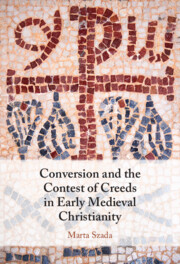Book contents
- Conversion and the Contest of Creeds in Early Medieval Christianity
- Conversion and the Contest of Creeds in Early Medieval Christianity
- Copyright page
- Dedication
- Contents
- Acknowledgements
- Abbreviations
- Introduction
- 1 Religious Controversy and Conversion in Vandal Africa
- 2 Building the Christian Kingdom
- 3 The Vandal Wars and Conversion in East Roman Africa
- 4 Nicene–Homoian Conversion in Ostrogothic Italy
- 5 Nicene–Homoian Conversions in Lombard Italy
- 6 The Religious Controversies in Gaul and Hispania before the Goths
- 7 Family Life and Conversion in Gaul, Hispania, and Italy
- 8 Converting the Kings
- 9 Converting the Kingdom
- Conclusion
- Sources
- References
- Index
1 - Religious Controversy and Conversion in Vandal Africa
Published online by Cambridge University Press: 06 June 2024
- Conversion and the Contest of Creeds in Early Medieval Christianity
- Conversion and the Contest of Creeds in Early Medieval Christianity
- Copyright page
- Dedication
- Contents
- Acknowledgements
- Abbreviations
- Introduction
- 1 Religious Controversy and Conversion in Vandal Africa
- 2 Building the Christian Kingdom
- 3 The Vandal Wars and Conversion in East Roman Africa
- 4 Nicene–Homoian Conversion in Ostrogothic Italy
- 5 Nicene–Homoian Conversions in Lombard Italy
- 6 The Religious Controversies in Gaul and Hispania before the Goths
- 7 Family Life and Conversion in Gaul, Hispania, and Italy
- 8 Converting the Kings
- 9 Converting the Kingdom
- Conclusion
- Sources
- References
- Index
Summary
Chapter 1 provides the broad context of Nicene–Homoian interactions in Africa, including those that preceded the Vandal conquest. It examines the involvement of the African church in the Trinitarian controversy of the fourth century and its intertwining with the Donatist crisis as these experiences explain the later attitude of the African clergy toward Vandal Homoianism.
Keywords
- Type
- Chapter
- Information
- Publisher: Cambridge University PressPrint publication year: 2024

